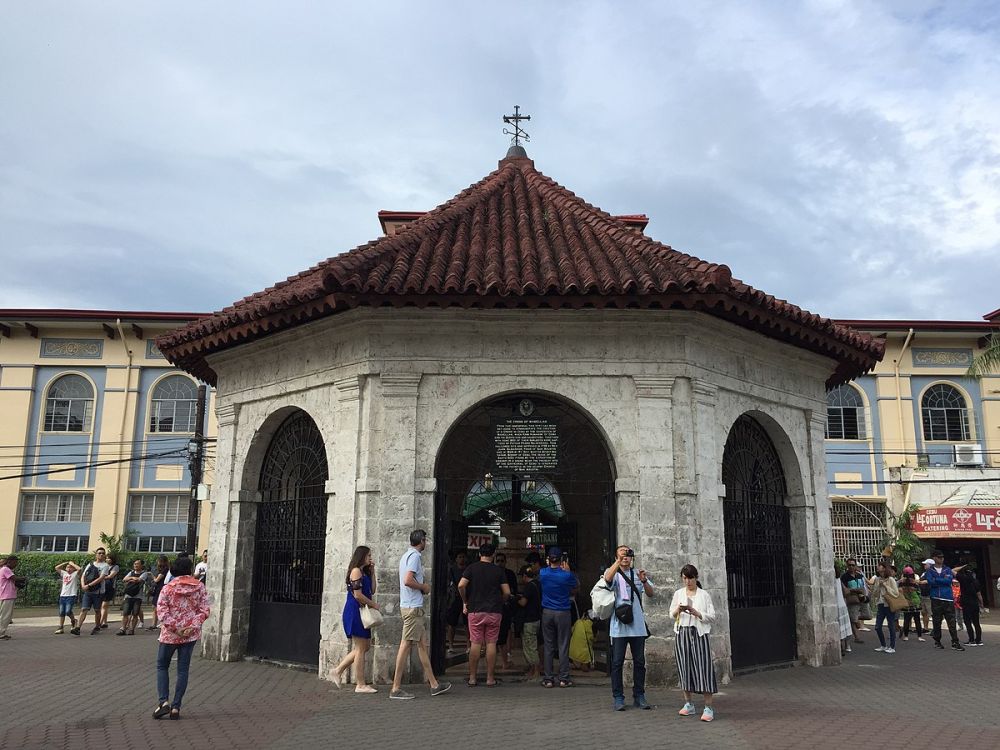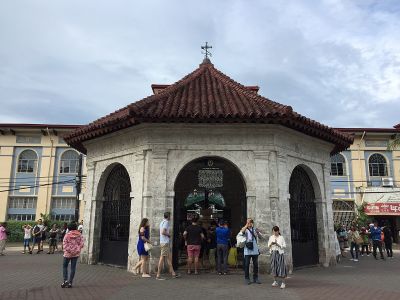

One of Cebu City's most iconic and historical landmarks, Magellan's Cross, is a must-see for any traveler. The cross is housed in a small chapel next to the Basilica Minore del Santo Niño on Magallanes Street. Magellan's Cross is a symbol of Christianity in the Philippines, marking the spot where the Portuguese explorer Ferdinand Magellan planted a wooden cross upon his arrival in 1521. Visitors can marvel at the beautiful paintings on the ceiling that depict the story of Magellan's landing and the introduction of Christianity to the islands. You'll experience a sense of history as you stand in front of the cross, which is actually encased in another wooden cross made from Tindalo wood to protect it from deterioration. The site is often visited by pilgrims and tourists who leave flowers and light candles for prayer intentions.
Outside the chapel housing Magellan's Cross, you'll find a number of candle vendors, often older women known as 'mamumulong' who offer a unique experience: a candle lighting ritual with prayer. They'll perform a traditional Sinulog dance while chanting blessings and prayers in Cebuano. This dance is a local tradition believed to bring good fortune and answer prayers. As a visitor, you can purchase a bundle of candles, each color representing a specific aspect of life such as health, peace, love, or prosperity. Participants are expected to say a silent prayer as the vendor performs the ritual. It's a spiritual and cultural engagement, giving you an opportunity to immerse yourself in the local religious practices and beliefs.
Adjacent to Magellan's Cross is the Basilica del Santo Niño, a 16th-century church that is home to the revered Santo Niño de Cebu statue. Inside the Basilica's complex, there is a museum that visitors can explore to learn more about the religious and cultural history of Cebu. The museum showcases antique relics, statues, furniture, and garments, as well as the history of the Basilica itself. Visitors can spend time examining old vestments, church documents, and other religious artifacts. The tour provides an insightful backdrop to the Magellan's Cross experience, deepening the understanding of Cebu's Catholic heritage. It's an interesting journey through time that highlights the significance of the Santo Niño in Philippine history and the role of the church in the local community.
Although not located at Magellan's Cross, Fort San Pedro is a historic military defense structure in Cebu City and is well worth a visit after seeing the cross. Built by the Spanish under the command of Miguel López de Legazpi, this fort served as a military stronghold against invaders. Today, it's a peaceful place that offers a window into the colonial past of the Philippines. The fort's museum holds exhibits of Spanish artifacts such as documents, paintings, sculpture, and weaponry from the Spanish colonial period. Exploring the fort's bastions, walls, and gardens is an engaging way to spend an hour or two, taking in panoramic views of the city and learning about Cebu's history.
Close to Magellan's Cross, you will find the Cebu Heritage Monument, which is a tableau made of concrete, bronze, brass, and steel showing scenes of significant events in the history of Cebu. This includes the baptism of Rajah Humabon and the Battle of Mactan between Lapu-Lapu and Magellan. The monument gives a comprehensive glimpse of the rich history of the island. Sculpted by Filipino artist Eduardo Castrillo, the structure was completed in the year 2000. Visitors come to see the intricate details of the monument and take photos. It's an excellent place to further your knowledge of the local culture and the pivotal moments that have shaped it.
For those interested in architecture and history, a cultural walking tour in the historic Parian district of Cebu City, starting from Magellan's Cross, is an excellent way to spend half a day. You'll pass by centuries-old buildings, significant cultural landmarks like the Jesuit House and Yap-Sandiego Ancestral House, and see a variety of Spanish-era houses. In addition to this, a guide will provide fascinating narratives about the history of each site. The tour includes stops at important religious and cultural venues, offering a deeper understanding of Cebu's historical and social development. A walking tour of this nature is a valuable activity for any history buff or cultural enthusiast.
Cebu is known for its rich culinary heritage, and a trip to Magellan's Cross is incomplete without sampling some of the local dishes. Visitors should seize the opportunity to try Cebu's famous lechon, a succulent roasted pig that’s a staple at Filipino feasts. Walking tours often include a stop at a nearby restaurant or market where you can sample this delicacy along with other regional foods, such as puso (hanging rice), suTuKil (a combination of different cooking methods: Sugba, Tula, and Kilaw), and Cebuano street food. A local food adventure gives insight into the flavors and ingredients that make up the island's gastronomic culture. It's also a tasty way to experience the local way of life.
Around the area of Magellan's Cross, visitors can engage in a handicraft shopping experience that showcases the best of Cebu's local arts and crafts. Artisans from Cebu and the surrounding islands are known for their skill in creating beautiful, handcrafted goods such as jewelry, fashion accessories, wood carvings, and woven products. Visitors will find numerous stalls and stores offering a variety of souvenirs, from keychains and T-shirts to more unique and intricately made items. This gives tourists a chance to buy authentic, locally made gifts and souvenirs to bring home, while simultaneously supporting the local economy and preserving traditional crafts.
A stone's throw from Magellan’s Cross, Colon Street is recognized as the oldest street in the Philippines. A historical walk down this busy thoroughfare is an activity that blends commerce, history, and local color into one. Established during the Spanish period, Colon Street has witnessed the evolution of Cebu City from a sleepy town to a bustling urban center. Today, it is a lively commercial area with a mixture of modern establishments and rustic shops. History enthusiasts will appreciate seeing some old movie theaters and remnants of American and Spanish architecture. The nighttime is especially vibrant when street vendors sell affordable goods and the city's energy is palpable.
For those with a profound interest in the history and heritage of Cebu City, a comprehensive guided tour is indispensable. Starting from the iconic Magellan's Cross, the guided city tour encompasses multiple historical sites such as the Basilica del Santo Niño, Fort San Pedro, and the Taoist Temple, among others. Professional guides will provide rich narratives and anecdotes that bring the history of these sites to life. Participants will not only learn about the history of the cross but also the broader context of Cebu's role in Philippine history, its pre-colonial culture, the impact of Christianity, and the island's transformation throughout the centuries. A heritage tour like this is perfect for history buffs and those who appreciate the stories behind historical landmarks.
